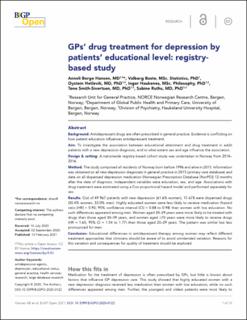| dc.contributor.author | Hansen, Anneli Borge | |
| dc.contributor.author | Baste, Valborg | |
| dc.contributor.author | Hetlevik, Øystein | |
| dc.contributor.author | Haukenes, Inger | |
| dc.contributor.author | Smith-Sivertsen, Tone | |
| dc.contributor.author | Ruths, Sabine | |
| dc.date.accessioned | 2021-02-12T11:52:30Z | |
| dc.date.available | 2021-02-12T11:52:30Z | |
| dc.date.created | 2021-01-05T08:37:07Z | |
| dc.date.issued | 2021 | |
| dc.identifier.issn | 2398-3795 | |
| dc.identifier.uri | https://hdl.handle.net/11250/2727733 | |
| dc.description.abstract | Background: Antidepressant drugs are often prescribed in general practice. Evidence is conflicting on how patient education influences antidepressant treatment. Aim: To investigate the association between educational attainment and drug treatment in adult patients with a new depression diagnosis, and to what extent gender and age influence the association. Design and setting: Nationwide registry-based cohort study, Norway, 2014-2016. Method: The study comprised all residents of Norway born before 1996 and alive in 2015. We obtained information on all new depression diagnoses in general practice in 2015 (Primary Care Database) and data on all dispensed depression medication (Norwegian Prescription Database) 12-months after the date of diagnosis. Independent variables were education, gender, and age. Associations with drug treatment were estimated using a Cox proportional hazard model, for genders separately. Results: Out of 49,967 patients with new depression (61.6% women), 15,678 were dispensed drugs (30.4% women, 33.0% men). Highly educated women were less likely to receive medication (Hazard Ratio (HR) =0.93, 95% CI (0.88 – 0.98)) than women with low education. No such differences appeared among men. Women aged 20-29 were more likely to be treated with drugs than those aged 30-59, and women aged 70+ were more likely to receive drugs (HR=1.65, (1.54 – 1.77)) than those aged 20-29. The pattern was similar but less pronounced for men. Conclusion: Educational differences in antidepressant therapy among women may reflect different treatment approaches that clinicians should be aware of to avoid unintended variation. Reasons for this variation and consequences for quality of treatment should be explored. | |
| dc.language.iso | eng | en_US |
| dc.rights | Navngivelse 4.0 Internasjonal | * |
| dc.rights.uri | http://creativecommons.org/licenses/by/4.0/deed.no | * |
| dc.subject | Depresjon | |
| dc.subject | Depression | |
| dc.subject | Antidepressive midler | |
| dc.subject | Antidepressants | |
| dc.subject | Helsetjenesteforskning | |
| dc.subject | Health services research | |
| dc.subject | Fastlege | |
| dc.subject | General practitioner | |
| dc.title | General practitioners’ drug treatment for depression by patients’ educational level: registry-based study | en_US |
| dc.type | Peer reviewed | en_US |
| dc.type | Journal article | en_US |
| dc.rights.holder | © 2020, Authors | |
| dc.description.version | publishedVersion | |
| cristin.ispublished | true | |
| cristin.fulltext | postprint | |
| cristin.fulltext | original | |
| cristin.qualitycode | 1 | |
| dc.identifier.doi | https://doi.org/10.3399/BJGPO-2020-0122 | |
| dc.identifier.cristin | 1865268 | |
| dc.source.journal | British Journal of General Practice Open | en_US |
| dc.relation.project | Norges forskningsråd: 287884 | |
| dc.subject.nsi | VDP::Allmennmedisin: 751 | |
| dc.subject.nsi | VDP::General practice: 751 | |

